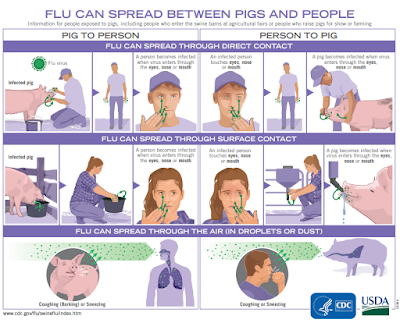
#17,001
Over the past dozen years attendance at state and country fairs with swine exhibits have been the primary exposure risks for people who have been infected with novel swine-variant influenza viruses (H1N1v, H1N2v, H3N2v).
Although swine variant viruses existed before that time, they took on new prominence in the fall of 2011 when a new strain of swine H3N2 emerged in American pigs which was a triple reassortant virus; one that had picked up (via reassortment) the matrix (M) gene from the 2009 H1N1 pandemic virus.
The following year, the CDC would speculated that:
`This M gene may confer increased transmissibility to and among humans, compared to other variant influenza viruses.’ – CDC HAN 2012
This year, now that venues have opened up again, we've started to see a smattering of cases again, prompting the CDC last month to issue the following advisory: CDC HAN #00473: Variant Influenza Virus Infections: Recommendations for Identification, Treatment, and Prevention for Summer and Fall 2022.
While it is rare to see swine variant viruses spread efficiently in humans, and most cases are mild or moderate, the CDC's IRAT (Influenza Risk Assessment Tool) lists 3 North American swine viruses as having at least some pandemic potential (2 added in 2019).
H1N2 variant [A/California/62/2018] Jul 2019 5.8 5.7 ModerateH3N2 variant [A/Ohio/13/2017] Jul 2019 6.6 5.8 Moderate
H3N2 variant [A/Indiana/08/2011] Dec 2012 6.0 4.5 Moderate
The CDC's Assessment of the Risk from these viruses reads:
CDC Assessment
Sporadic infections and even localized outbreaks among people with variant influenza viruses may occur. All influenza viruses have the capacity to change and it’s possible that variant viruses may change such that they infect people easily and spread easily from person-to-person. The Centers for Disease Control and Prevention (CDC) continues to monitor closely for variant influenza virus infections and will report cases of H3N2v and other variant influenza viruses weekly in FluView and on the case count tables on this website
Although most fairs have requirements the screening and barring of `sick pigs' from exhibition, over the years we've learned that many pigs may be infected asymptomatically (see EID Journal: Flu In Healthy-Looking Pigs and Transmission Of Swine H3N2 To Humans At Agricultural Exhibits - Michigan & Ohio 2016).
- Issues for Fair Organizers to Consider When Planning Fairs
- Take Action to Prevent the Spread of Flu Between Pigs and People | CDC
- Key Facts for People Exhibiting Pigs at Fairs
- What People Who Raise Pigs Need To Know About Influenza (Flu)
- Compendium of Measures to Prevent Disease Associated with Animals in Public Settings, 2017
Volume 28, Number 10—October 2022
Research
Shortening Duration of Swine Exhibitions to Reduce Risk for Zoonotic Transmission of Influenza A Virus
Dillon S. McBride, Jacqueline M. Nolting, Sarah W. Nelson, Michele M. Spurck, Nola T. Bliss, Eben Kenah, Susan C. Trock, and Andrew S. Bowman
Abstract
Reducing zoonotic influenza A virus (IAV) risk in the United States necessitates mitigation of IAV in exhibition swine. We evaluated the effectiveness of shortening swine exhibitions to <72 hours to reduce IAV risk. We longitudinally sampled every pig daily for the full duration of 16 county fairs during 2014–2015 (39,768 nasal wipes from 6,768 pigs). In addition, we estimated IAV prevalence at 195 fairs during 2018–2019 to test the hypothesis that <72-hour swine exhibitions would have lower IAV prevalence.
In both studies, we found that shortening duration drastically reduces IAV prevalence in exhibition swine at county fairs. Reduction of viral load in the barn within a county fair is critical to reduce the risk for interspecies IAV transmission and pandemic potential. Therefore, we encourage fair organizers to shorten swine shows to protect the health of both animals and humans.
(SNIP)
During 2014 and 2015, we conducted daily IAV testing at 8 agricultural fairs in the United States, in which we sampled all exhibition swine every day to measure changes in prevalence longitudinally during the exhibitions. We then evaluated IAV in swine at agricultural fairs that had implemented the shortened, 72-hour recommendation for swine exhibitions compared with fairs that did not during 2018 and 2019.
(SNIP)
Discussion
Through 2 active IAV field surveillance efforts, we found strong evidence that shortening the duration of swine exhibitions greatly reduces IAV prevalence in swine. In our longitudinal study sampling every pig every day, the IAV prevalence and hazard estimate at each IAV-positive fair rose consistently with increasing time at the fair, as we expected in the case of a growing infectious disease outbreak. Accordingly, if fairs had shortened their swine exhibitions, the maximum prevalence by the end of the fair would have been greatly reduced.
For example, fair 2014 H and fair 2015 B displayed relatively parallel growth curves (Figure 1), and both had a PCR prevalence of 19.8% at the sixth sampling interval (121 hours after arrival at fair 2014 H and 110 hours after arrival at fair 2015 B). A critical difference between the 2 fairs, however, is that 2014 H ended after that sampling, resulting in the second-lowest end-of-fair prevalence in our study. In stark contrast, 2015 B had pigs on site through 153 hours and ended with 94.2% IAV PCR prevalence, the study’s second-highest peak prevalence.
Despite a rise in IAV-positive samples through the first 6 days, in ending ≈2 days earlier, IAV prevalence at 2014 H never exceeded 20%, greatly reducing the viral load in the barn at the end of the fair and reducing the risk for zoonotic transmission.
After two years of pandemic lock down - and very little flu exposure - our community immunity to influenza A viruses is thought to be very low, raising concerns that seasonal flu may return this fall with a vengeance.
Which is why I've scheduled my yearly flu shot for later this morning.

